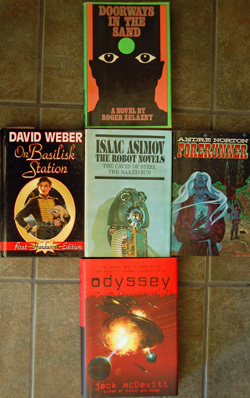Jane Lindskold's Blog, page 133
October 23, 2014
TT: Big Car, Little Car
ALAN: Having grown up with the British mini which really is very tiny indeed, I find it hilarious that Americans refer to what I consider to be stonking great big people movers as “minivans. “

Big Car, Little Car
JANE: You described the mini last Tangent, but I fear that your statement that you find “it hilarious that Americans refer to their stonking great big people movers as ‘minivans’” doesn’t make much sense. Minivans aren’t really that big. They are certainly not “great big people movers” – most don’t hold more than six or seven people, and those people had better like each other a lot and not have much in the way of luggage.
ALAN: Here, anything that holds “six or seven” people is absolutely huge. It’s the largest vehicle a person is allowed to drive on an ordinary license. Most cars hold four people. Perhaps five if the journey is short and you are all intimate friends…
JANE: I still insist that minivans aren’t really huge. They’ve just replaced the station wagon of my childhood and, honestly, seem to hold a lot less in the way of luggage.
ALAN: We have station wagons as well, but they are just cars with two seats in the back, and a larger than usual luggage area. So they still hold four people, but they let you carry a lot more junk than you could cram into a proper car.
JANE: The station wagons of my childhood held six or seven people, three in front, three or four in back. Sometimes, in those wild and woolly days before mandatory seat belts, kids would sprawl in the back cargo area. I have fond memories of the summer we drove from D.C. to Omaha, Nebraska. I was small enough that I could lie down in the back and read or color. These days I can’t read in a moving vehicle – I get motion sick.
Returning to terminology, we never refer to “minivans” as “minis.” It’s always a compound where minivan is a sub-class of van.
ALAN: We have minivans, but they are just a standard mini (the car) which has a van body and therefore only seats two people in the front. Everything else is empty space. They don’t really exist anymore – I haven’t seen one in decades. I suspect that my minivan would fit comfortably on the back seat of your minivan and still leave room for a passenger or two. It’s that incongruity which makes me laugh at the word.
JANE: I see… Same word, different meaning entirely. I might as well fill you in on the rest…
“Vans” hold more people and indeed might be called “people movers.” Vans can hold between twelve and fifteen people. Jim commuted in such a van for years. He requests that I clarify that if you squeeze fifteen people in, they’d better really like each other.
We call “stonking great people movers” “buses.”
ALAN: Here, anything that holds a dozen people or more is a bus, and it is never owned or driven by ordinary people – you need a special kind of license to drive anything that big.
JANE: I checked with Jim. He regularly drove his commuter van and didn’t need any special license.
Now, to go the opposite direction, not all Americans drive huge vehicles. My car is a sedan – a Mazda Protégé. I think it’s about the same size as your car – comfortable for four, but with the option of squishing in a fifth. There are many smaller models on the road, as well, two door sedans, hatchbacks…
One of the most peculiar small cars is the Smart Car. These are so small that I, personally, wouldn’t take one onto a highway – especially out here in the wild West where there are a lot of big pickup trucks on the roads. In many ways, they sound like a modern variation on your mini.
ALAN: Are the Smart Cars those things sponsored by Google that drive themselves? I’ve seen photos of those and they do indeed look very small.
JANE: I don’t think so… They’re just really small cars with room for only two passengers, very little cargo space, and a very low profile. They’re touted as “smart” because they have very low gas mileage. I’ve only seen them, never driven one, but maybe our readers could tell you more.
ALAN: Ah, I see! That does sound really, really small.
JANE: I have a question for you… Earlier you mentioned that “Most cars hold four people. Perhaps five if the journey is short and you are all intimate friends…”
What do families do? When I was a kid, my family numbered two adults and four children. No way we could all fit in a sedan. These days, especially given that bulky car seats are now required for small children, many families drive minivans, SUVs (compact versions are common), or other larger vehicles. They need to in order to fit!
ALAN: The problem seldom arises. Most families have only two children – larger families are the exception rather than the rule. Two adults in the front and two children’s car seats in the back and Robert is your avuncular relative. Of course, the rare families larger than this may well have a larger vehicle that holds half a dozen or so people. Actually, it’s the only real justification I can think of for driving one of these. They really do look quite out of place on our rather narrow roads.
JANE: Seriously, Jim and I have the Forester because there some of our hobbies – including our garden, landscaping, and such – benefit from the ability to haul material. There have been times I’ve seriously missed our pickup truck.
ALAN: I think my view of American cars might have been much influenced by Eartha Kitt’s song An Old Fashioned Girl where she claimed to want “…a cerise Cadillac, big enough to put a bowling alley in the back…”
JANE: Yes. I can see that. There’s also the blues hit, “Riding with the King,” as well as songs about low riders and other models where customization, not just size, are important. But one must be careful. Sometimes a car is not just a car… It’s a metaphor. Go look up Bruce Springsteen’s “Pink Cadillac” or Prince’s “Little Red Corvette,” if you want to figure that one out.
ALAN: Strange how we keep coming back to music. I think the Tangent Gods are dropping a very large hint here…
Do you think the fascination with cars is purely American?
JANE: Hey, the Beatles were the ones who sang, “Baby, You Can Drive My Car.” And Lord Peter was devoted to his Daimlers. I’m really not certain that it’s just an American thing to see a car—especially one that’s large and elaborate – as a status symbol.
ALAN: You’re quite right. Nothing proclaims your status like a Rolls Royce and that’s about as British as it gets. And, if we are sticking to the music theme, Gary Numan (ex Tubeway Army) had a massive hit in the UK with a song called simply Cars.
JANE: And here in the U.S., we had a band called, the Cars. You’re right. One of these days, we’re going to need to discuss music…


October 22, 2014
A Scattering of Stuff
Last week was a busy swirl. I can hardly sort day from day. Still, if you join me in imagining these as sort of like Muppet News Flashes, I think I can get through.

Tomato Plants: This Will Make Sense by the End
News Flash: I’ve been invited to be Guest of Honor at the 2015 Conduit in Salt Lake City. It’s over Memorial Day weekend, May 22 to 24. We’re already planning some special events, so it should be a great time. I hope some of you will be able to join us.
News Flash: The release date for Artemis Invaded has been finalized. Look for it June 30, 2015.
News Flash: Wanderings on Writing is nearly done. We’re messing around with fonts for page headers and looking for potential printer errors. The cover looks great and I’m pleased with the contents, too.
News Flash: I’ve started constructing the manuscript for the book of short stories you folks requested several months back. In addition to an introduction, each story will have its own afterpiece, talking a bit about what went into each story. Writing these has been a real trip down Memory Lane for me since, in many cases, over twenty years have passed since the story was published.
I’m starting with some very early pieces, then will do some skipping around. What’s been really fascinating is how many people have said, “Are you going to include such and such story?” It’s interesting to find out which stories have remained vivid in reader’s minds. So far “Jeff’s Best Joke,” “Keep the Dog Hence,” “The Travails of Princess Stephen,” and “Hunting the Unicorn” have been requested. Any others?
I’ve been debating on whether to include previously published original stories set in the universes of my Firekeeper novels, The Buried Pyramid, and Changer. Many fans of these novels never saw these stories. What do you think?
In case you wondered, I’m not including any of the stories I wrote for someone else’s universe. I’m debating including these in another collection. I’m also not going to include any of my short stories with continuing characters (such as the “Albuquerque Adepts” or Andrasta).
News Flash: Remember you can download my most recent short story, “Born from Memory” for free from the Science and Fantasy Fiction website.
Since we recently acquired a bunch of new readers, let me mention a few projects related to my work that you can download for little or nothing. Here’s a short list:
Thursday Tangents free ebook, with original introductions by me and Alan Robson. Alan supplies a table of contents here or you can go to “My Books” for a free download.
What would you be if you lived on Artemis?” quiz.
“My Love is Like a Panther Swift,” an original song by Chad Merkley, based on and expanded from lyrics that appear in Artemis Awakening.
Various interviews, both audio only and film are available via my website. Links here.
For less than a dollar you can download several original short stories, including “Hamlet Revisited” and “Servant of Death” from Snackreads.
And the Captain Allie stories, individually, or in the collection Star Messenger, available via my website bookstore, Barnes and Noble, or Amazon.com.
If you feel like spending a little more, my novels Changer and Changer’s Daughter (originally published as Legends Walking) are now available both as e-books and print on demand. Want your book signed? Go to my website bookstore and order from there.
News Flash: I’ve recently started Twittering @JaneLindskold.
Also, my author page on Facebook is a great place to go for reminders about contests or on-going projects like the A Night in the Lonesome October book club that’s still on-going (and getting really intense now) on Twitter. #LonesomeOctober
Wow! I believe I’m “newsed out”! It’s a lovely autumn day here and, although the frosts at night have been nibbling at the leaves of my squash and basil, I still have a pretty nice garden. I think I’ll step outside and pick tomatoes.
I forgot to buy bacon this week. I really need to do so while we can still make BCR’s – bacon, Swiss chard, and Roma tomato sandwiches!


October 17, 2014
FF: Seriously Fragmented
The Friday Fragments feature lists of what I’ve read over the past week. They are not meant to be a recommendation list. If you’re interested in a not-at-all-inclusive list, you can look on my website.
This is not a book review column. It’s just a list with, maybe, a few opinions tossed in.

Snowdrop contemplates October
This week has been an interesting one…
What are you reading?
Recently Completed:
The Sphinx of the Ice Realm by Jules Verne, translated by Fredrick Paul Walter. Looking for a stirring sea saga with bits of mystery, secret identities, and a neat twist at the end? This Verne is for you. I strongly suggest this translation for the notes and introduction.
Smoking Seventeen by Janet Evanovich. Audiobook.
Explosive Eighteen by Janet Evanovich. Audiobook.
In Progress:
Clariel by Garth Nix. A prequel of sorts to the “Abhorsen” books. I’m enjoying, although the “action” at the start is mostly internal.
The House of Hades by Rick Riordan. Audiobook. Yet another reader! I miss Leo’s accent.
A Night in the Lonesome October by Roger Zelazny. Still trying to hold to one chapter a day for the Twitter book club at #LonesomeOctober. This is getting much, much harder as the plot gets more complex.
Land of Cinnamon Sun by John Nizalowski. A collection of essays. I’ve been reading an essay or so before bed. Enjoying.
Also:
I’m starting to re-read my own short stories as part of putting together a collection. Just read my first, published in 1990.


October 16, 2014
Baby, You Can Drive My Car (Or Maybe Not)
JANE: So, Alan, last time we were discussing the psychological oddities involved in the fact that you and I each drive on the wrong side of the road, at least from each other’s point of view. I bet that if we looked, we’d find a lot of other interesting oddities regarding our attitudes toward driving and cars.

All Backwards — To Me
ALAN: Because the Japanese drive on the left just like we do, we have a huge number of imported second-hand Japanese cars on our roads. I own one myself. It has a switch on the dashboard whose function is utterly mysterious to me. And since the owner’s manual is in Japanese, I’ll probably never find out what it does.
JANE: If you want to scan the page and e-mail it to me, I’ll see if my friend, Cale, can translate it for you. It would be a pity if you didn’t realize that you had missile launchers or laser beams… Or even the hover vents that would let you rise about traffic.
ALAN: Gosh! That would be impressive…
My car has all the original factory fixtures and fittings. That includes a radio, of course, which also leads to problems since Japanese radio stations broadcast on a different range of frequencies than the ones we use. So the unmodified Japanese radios can’t actually pick up stations that I like to listen to. There is a gadget which can be fitted to address this problem, but it isn’t very satisfactory…
JANE: If you don’t want to fix it, you can simply listen to recorded music. I gave up on radio a while back. Now I have a selection of CDs I keep in the car. My current favorite is a David Bowie compilation.
Jim’s vehicle is new enough that it came with a jack for a data stick. I encouraged him to record a bunch of “his” music, so I can learn more about bands he likes. It’s been a lot of fun. I have a lot more appreciation for Jimi Hendricks, Cream, The Who, and Led Zeppelin than I did. I mean, I’d heard the hits, but now I’ve listened to entire albums.
But I am straying from cars…
ALAN: We have a CD player as well and so we keep a lot of music in the car for long journeys. Robin and I have eclectic tastes (we like everything except country and western), but our major tastes were formed in the sixties and seventies and most of our music dates from that time. We’d both agree happily with Jim’s selections.
JANE: One of these days we should discuss music. I just realized that most of the bands I listed were British and we certainly don’t only listen to Brits! But back to cars…
ALAN: Yes, but let’s resist the lures of that tangent for the moment. The Japanese cars have an undeserved reputation for being of poor quality. The phrase “jap crap” is sometimes used. There was a huge scandal a few years back when it emerged that the majority of the used imports had had their odometers spun back so that the cars appeared to have done very low mileage. We have much stricter laws now and that scandal appears to have gone away.
JANE: That’s interesting. In the United States, Japanese cars, overall, have a very high reputation. I don’t think we’re part of their used car market, though, which may account for the difference.
ALAN: Actually, I’ve always found Japanese cars to be manufactured to a very high standard as well. Of course, we don’t have an indigenous car manufacturing industry so all our cars are imports, both new and used. There was a time when we assembled cars under license from overseas manufacturers, but we don’t even do that anymore.
However I’m not in the least bit surprised that you don’t have Japanese imports. After all, you’d have to swap the steering wheel round before you could drive them.
JANE: Funny man…
I am not an expert on cars by any means, but I do know that many “foreign” cars sold in the U.S. are actually manufactured here. And many “American” cars are wholly or partly manufactured elsewhere.
At one point in his life, Jim made a great effort to “buy American.” He bought a Ford truck, only to find out it had been built in Japan. His next vehicle was a Ford Festiva, which had been built in Korea. His next vehicle was a Nissan truck, which he learned had been built in Tennessee. The truck lasted him for something like nineteen years. It was still running when he traded it in, but he decided he’d really like to have air conditioning.
This time he didn’t bother to check who made what where and bought based on the reputation of the vehicle. So we now have a Subaru Forester and he likes it very much, especially the air conditioning and the ability to play his entire music collection.
ALAN: We have a Subaru as well. It’s a Subaru Legacy – just a car though. Not a truck.
The British have always enjoyed eccentric motor cars. The Reliant Robin which had three wheels and a fibreglass body, and the Austin A30 which, as an economy measure, had only one windscreen wiper (a passenger side wiper was available as an optional extra).
But the most famous was the Mini which was designed by Alec Issigonis. He got a knighthood for it. It first appeared in 1959 and it was the best-selling British car in history – the production run exceeded 5 million, and a mini-derived design is still being manufactured today. It had a very small 800cc engine, front wheel drive, and 10 inch wheels. The car was so tiny, that there used to be a joke in England that a pedestrian once got hit by a mini as they were crossing the road and they had to be taken to hospital to have it removed…
JANE:
ALAN: In another life, Robin was once a car mechanic in a garage. She specialised in minis because she was the only person in the garage whose hands were small enough to get into all those awkward places. There was so little space under the bonnet that other garages had to dismantle and then remantle the entire engine to do even the simplest maintenance jobs. But with Robin on the job, that wasn’t necessary.
JANE: I’ve seen minis here occasionally. They look like toys and always seem to be driven by very large men…
I wonder what that means?
ALAN: Speaking as a man, I have to say that I think Freud was perfectly correct. Sometimes a cigar really is just a cigar.
Because minis are so small, it is natural to try and get as many people as possible into one. According to the Guinness Book Of Records, the world record for cramming people into a mini is 27. This amazing feat was achieved on 18th May 2014 during the annual London to Brighton Mini Run. The 27 people were all female and included a mother and daughter and a pair of twins. The Guinness Book Of Records remains silent on the question of whether or not the mini could actually move with all those people in it…
JANE: Bet it couldn’t! Now, I need to go write, but I don’t think we’ve exhausted (get it, “exhausted”?) the topic of cars quite yet!


October 15, 2014
Suggestions for a Virgin (SF Reader)
Exciting news! “Born from Memory,” the short story I wrote to go with the first-place winning piece in the Science Fiction and Fantasy website art competition is now available as a free download. I really loved this story and I hope you will take the opportunity to read it.
And now, back to virgins. I mean books for new SF readers… Last week I raised the question of what books (or authors) you might suggest to someone who wanted to read SF, but didn’t know where to start.

A Few Suggestions
Lots of interesting suggestions came in, both via the Comments and to me directly. They kept coming in all week, so even if you looked last week, I hope you’ll go take another look.
One thing lots of people agreed upon was that any recommendation should be based on the reader’s interests. One Commenter, who is a professional librarian, even suggested some strategies for eliciting a helpful response. While I agree wholeheartedly that learning a bit about the potential reader is a good idea, I still think it’s helpful to have some ideas already prepared.
I don’t think I’m alone in that as soon as I’m asked to recommend a book, my mind goes blank. That’s one reason I have a list on my website. Even with that, I often finding myself recommending whatever I’ve read recently, even if that’s not the most appropriate choice, simply because it’s what I think of first.
However, lots of the books I list on my website wouldn’t necessarily be the best choices for a new reader. I’ve been reading SF for a long time and have developed rather quirky tastes.
Moreover, last week for reasons I detailed in that piece, I asked people to restrict their suggestions to SF, rather than Fantasy or Horror.
(Yes, yes, I know the designations are sometimes arbitrary. Alan Robson and I discussed this at some length on this site on starting 11/29/12, with additional entries on 12/06/12 and 12/13/12; we then spent weeks using these designations as an excuse to discuss books. Check these out!)
So, let’s take a closer look at books and authors we might suggest to someone who was interested in reading SF, but didn’t know where to start.
One of the “off-stage” commenters said that he would tend to recommend short fiction over novels. Certainly, SF has its roots in short fiction, but I’m not sure I’d agree with this choice. Many SF shorts are “idea” stories, clever enough in themselves but with a possibly off-putting element for a new reader, since idea stories often sacrifice character and setting to focus on a cute idea.
Readers, by contrast, at least modern readers – as supported by numerous comments on this site and elsewhere – are usually drawn to character over plot or setting.
That said, this doesn’t mean I wouldn’t recommend short fiction. Especially when the stories have some sort of internal connection – perhaps a continuing character or serving as part of a future history – short fiction can provide a wide sampling of SF themes and tropes.
Isaac Asimov’s “Robot” stories strike me as a good choice. They have a continuing theme to tie them together and a few recurring characters. Since humanoid robots have never become part of mainstream reality, stories built around them don’t “date” as easily.
When I was in college, I found Heinlein’s future history stories fascinating. Even though some of the concepts were already dated, the sense that the various pieces had a shared continuity provoked my interest. I haven’t looked at these stories in years but, I suspect that if I did, I’d find myself slipping into that parallel universe with ease. Other future histories – I’m very fond of those set in Larry Niven’s “Known Space” and of Poul Anderson’s Earthbook of Stormgate – also have potential.
We didn’t get much feedback from younger female readers, so I don’t know if these largely male-tenanted futures would present a problem or not.
One of the authors mentioned, James H. Schmitz, was ahead of the curve when presenting a future which included female characters who were presented simply as people – without in the least ignoring that when you put men and women in the same place they aren’t going to forget they’re men and women. I particularly love his Witches of Karres, which, despite the title, is full of spaceships and strange planets and stranger people.
Many of the authors suggested (Clarke, Asimov, Zelazny, LeGuin, Dick, McCaffery, Brunner, Norton) were older or, as marketing is starting to term them, “classic.” One of the off-site commenters noted that, in her opinion, a new reader was often looking for a newer book rather than a “classic.” There’s something to be said for this. Reading something “new,” when everyone else is, lets a new reader enter the discussion. A drawback, of course, is that a new reader may be impressed out of proportion with something that is “old hat” to a long-time reader.
Back when I was still teaching at Lynchburg College, I gave a reading at a campus event. One of my colleagues was impressed out of proportion by the fact that my characters paid for items with “credits.” She saw in this a projection of the evolving monetary system that was already taking place around us, where the use of cash or checks was being replaced by credit cards. (I’m not sure debit cards had entered widespread use.)
A new reader, unfamiliar with what is often termed the “furniture of the field,” might need to digest a whole bunch of new concepts – but, since this immersion in new ideas is the sort of exciting experience that often creates a lifetime reader of SF, I don’t see that as a bad idea.
So which “newer” writers might we suggest? David Weber’s name came up several times. I would strongly agree – with the caveat that if the potential reader didn’t like military settings, his “Honor Harrington” books might not be the best place to start. I usually recommend his Path of the Fury. (I’m not as familiar with the expanded reissue, In Fury Born.) The three Stephanie Harrington novels (two of which I co-wrote with him) are less military in nature and are solidly rooted in SF coolness.
Elizabeth Moon was mentioned. I’m not familiar with all of her work, but I was impressed by her Speed of the Dark. Firmly rooted in our current culture and its concerns, Speed of the Dark, nonetheless has some fascinating SF speculation and shows how those who are often seen as our misfits might be our path to the stars. I also really like her Remnant Population.
C.J. Cherryh’s “Chanur” novels have good aliens and lots of action without becoming overtly military. I’m not as familiar with her more recent work, but I’ve heard many good things.
Another current author I’d solidly recommend for beginners is Jack McDevitt. McDevitt often writes about continuing characters (star pilot and reluctant politician Priscilla “Hutch” Hutchinson in one series; art dealer Alex Benedict and pilot Chase Kolpath in another) but each novel stands on its own. The “Hutch” novels frequently include little news squibs at the end of each chapter, creating a nifty “future history” in miniature. The Alex and Chase novels have interstellar archeology, lost civilizations, and lots of intrigue.
Whether written ten years ago, twenty, or fifty, one of things that seems to give an SF novel longevity and make it interesting to a beginning reader is a “big” setting or concept. Those novels tied to immediate social concerns or trends date quickly. For this reason, “hard” SF, no matter how carefully thought through, often seems to go stale faster than the wildest space opera.
I’m sure there are lots of other books and authors that could be suggested… Perhaps some of you would care to offer your own suggestions of “non-classic” but still gripping SF tales that would lure in a new reader.


October 10, 2014
FF: All Over the Place
The Friday Fragments feature lists of what I’ve read over the past week. They are not meant to be a recommendation list. If you’re interested in a not-at-all-inclusive list, you can look on my website.
This is not a book review column. It’s just a list with, maybe, a few opinions tossed in.

Sirenity Contemplates Bubo the Rat
This week my reading is all over the place – even more than usual.
What are you reading?
Recently Completed:
The Mark of Athena by Rick Riordan. Audiobook. Rambled a bit as Riordan tried to deal with the fact that he had seven really powerful protagonists and a limited framework for action. Piper gets slighted. Jason spends an amazing amount of time unconscious. However, I did enjoy and plan to go onto the next book.
Dorsai by Gordon Dickson. I really enjoyed this. However, after having read three in a row, I’m troubled more now than I was originally by how little room there is for dynamic women in this future history. Not enough to keep me from recommending, but it would be with a caveat.
In Progress:
A Night in the Lonesome October by Roger Zelazny. Trying to hold to one chapter a day for the Twitter book club at #LonesomeOctober. Finding this very difficult.
Land of Cinnamon Sun by John Nizalowski. A collection of essays. I’ve been reading an essay or so before bed. Enjoying.
The Sphinx of the Ice Realm by Jules Verne, translated by Fredrick Paul Walter. The first chapter is slow. After that, it’s lots of fun. The intro is good, but I think I’d suggest waiting to read it until after reading the novel. The translators notes are great. I have them bookmarked, so I can check them as they come up.
Smoking Seventeen by Janet Evanovich. Audiobook. I needed a change from teenage demigods. This is quite the change!
Also:
Some Chinese mythology, especially about the Eight Immortals. Not sure if it’s going to go anywhere, but fun nonetheless.


October 9, 2014
TT: Full Stop, Not Period
JANE: So, Alan, while we’re on the subject of British English, back when you sent me your retirement speech (which was very amusing), you used the term “full stop” to mean what we would call a “period.”
That’s well and good but, here in the U.S., the term “full stop” is used completely differently. I assume you folks have the equivalent of stop signs, right?

An Important Sign
ALAN: Yes. Strangely, we call them stop signs…
JANE: Smart aleck! I needed to check. For all I know, you could call them “Halt Posts” or something else in need of interpretation.
Getting back to my point, here a driver is supposed to come to a “full stop” at one of these signs. Far too often, drivers instead come to a “rolling stop” – which is just what it sounds like, slowing down, but not completely stopping.
So, what do you folks call the traffic “full stop”?
ALAN: We stop, or sometimes halt, at a stop sign. Not stopping (even if you can see that the way is clear) is an offence and you can be fined for it. So in those circumstances, the thing that you call a “rolling stop” is illegal.
JANE: It’s illegal here, too. However, some people still do it, especially when they think the way is clear. And I guess the terminology has evolved so that police officers have something to write on a citation or use when issuing a warning. “Ma’am, you must come to a full stop at a stop sign, but you only came to a rolling stop. That is not acceptable.”
ALAN: We do slow down at “Give Way” signs and at unsigned intersections (particularly if we don’t have right of way) and, if necessary, we stop. That slowing down probably corresponds to your “rolling stop,” but we don’t use the phrase.
JANE: “Give Way?” Hmm… That’s probably the equivalent of what we call a “Yield” sign. We’re not required to slow down at unsigned intersections at all. I’m not sure if that’s a very good custom because I think that contributes to people blowing through stop signs.
I wonder if traffic signs – at least as far as shape and color go – have been universalized? I’m not enough of a world traveler to know.
ALAN: There is an international standard for road signs – it’s known as the Vienna Convention. However, the signatories to the convention are mostly in Europe, though strangely Brazil, Chile and the countries in the Yucatan peninsula have also signed it.
The USA, Australia and New Zealand have not signed it. Despite that, I think there’s still a huge overlap – after all traffic is traffic is traffic. I imagine though that we have a fair bit of leeway and while I suspect you’d recognise most signs over here, we do have our idiosyncrasies. For example, there’s a road that Robin and I drive along which requires us to “Beware of Penguins” – there’s a stylised picture of a penguin along with the text. The road goes along the coast with the sea on one side of it and the penguins’ nesting area on the other. Needless to say, the penguins have right of way.
JANE: Oh! Send me a picture! That’s priceless!
Here in New Mexico, cows have right of way, but that’s not nearly as much fun as penguins.
ALAN: And in Australia you often see signs with a stylised black silhouette of a leaping kangaroo on a yellow background. Obviously “Beware of Kangaroos.” I once saw one of these signs that had been vandalised. Somebody had drawn a silhouette of black lumps falling out of the leaping kangaroo’s bottom. I laughed so hard when I saw it that I almost lost control of the car!
JANE: During our long drives to visit family (my mom lives part-time in Arizona; my dad used to live in Colorado), Jim and I frequently see signs announcing “Elk Next 50 miles” (mileage will vary). We eagerly look for elk, but have never yet seen one. We’ve seen buffalo, though… That was distinctly startling.
While I’ve never seen scatological vandalism, for the longest time every one of these elk signs would have a tiny crown painted over the elk. (I should clarify that, as with the Australian kangaroo, the elk was represented by a silhouette, not a word.)
This doubtless puzzled, and continues to puzzle, drivers. However, we heard that the reason for this was that the emblem of the regional chapter of the SCA was a crowned elk, and that someone decided to turn all these signs into the emblem.
ALAN: That’s the power of advertising for you. Nothing is sacred…
Actually, ignoring the road signs for the moment, there’s a very fundamental automotive difference between you and me. The fact that we drive on the left and much of the rest of the world drives on the right can be a source of confusion to most visitors to New Zealand. Many tourists hire cars and camper vans for their holiday and sadly there are quite a lot of injuries and deaths caused by the tourists having the wrong driving reflexes and reacting badly in a crisis. I once saw a car with a hand-lettered sign in the back window. It said: “American Tourist. Please be patient!” I thought that was an excellent idea. Perhaps such signs should be mandatory.
JANE: I agree!
ALAN: I must confess that I dread the thought of visiting a country like America and having to drive on the “wrong” side of the road. I think it would be very scary.
As a side effect though, when I read descriptions of car chases in American novels, I am completely unable to visualise what’s going on. The pictures of traffic in my head are all left handed and I simply cannot transpose the one onto the other. Like Winnie the Pooh, I am a bear of very little brain and I easily get confused.
JANE: I can understand why. I find your version very confusing.
As I’ve mentioned, Jim and I watch a lot of anime. Japanese drivers sit on the right side of the vehicle. We were recently waiting the very noir series Witch Hunter Robin. In this tale, there are several scenes where characters hold covert meetings in parked cars. I’ll admit, there’s been a time or two when what my brain persists on perceiving as the car’s driver gets out of the car. Then I jump when the car pulls out into traffic.
Who’s driving?!!
ALAN: Sometimes it’s the tiniest things that get in the way. In America, Australia and New Zealand, the signs on the motorways that tell you how far it is to the exit and where the exit road leads to are all white letters on a green background. However in England the motorway signs are white letters on a blue background. The first time I saw the green signs on a New Zealand motorway, I was quite flummoxed. It was far too foreign. It was wrong!
JANE: I’d feel the same way, too. Still, it might be safer… In New Zealand, those “right” colors might lead me to forget that I needed to drive on the wrong side.
ALAN: The scientist in me wants to do an experiment. Come for a visit, drive me somewhere, and let’s see what happens next.
JANE: Oh, lordy! That’s a terrifying prospect… Still, if Jim and I ever make it there, we’ll need to find a quiet road and experiment. Then you and I can write a Tangent about it!


October 8, 2014
Read This! Or This? Or, Maybe, This?
At a meeting last week, an older (but still very active) writer of SF told how he had been asked by someone who had never read SF where she should start.
Eyes shining, this gentleman said his reply was something along these lines. “I said I wished I could be where she was, starting all over again. Then I mentioned H.G. Wells and Jules Verne…”

What to Suggest?
On some level I couldn’t place at the time, this answer bothered me. It wasn’t until a couple of days later that why I was bothered crystalized. I’d finished my current read (Dorsai by Gordon R. Dickson) and, when looking at my “to be read” shelf, I realized that I hadn’t finished the new translation of Jules Verne’s Sphinx of the Ice Realm.
My not finishing had nothing to do with the novel as such, but rather with the volume’s format. In order to pack a considerable amount of material into a 413-page trade paperback –in addition to Verne’s novel, the volume also includes a fascinating introduction, annotations, and the complete text of Edgar Allan Poe’s The Narrative of Arthur Gordon Pym (which inspired Verne’s Sphinx) – the publisher used very tiny print. This challenged my eyes – especially at the end of the day, which is when I usually have time to read.
As I skimmed the opening, trying to decide whether Sphinx would be my next read, I found myself remembering what had been said at the meeting. Would I recommend Verne and Wells to a new reader of SF? My gut feeling was “absolutely not.” Both writers were born in the 1800’s: Verne in 1828, Wells in 1866. While both were quite creative for their time, much of what they wrote about has become part of the “furniture” of the field: time travel, invisibility, moon shots, mutants.
Moreover, their technology and science is distinctly dated. When Verne wrote about Captain Nemo and the Nautilus, the submarine and its capacities were purest SF. Today, submarines are reality. Another example… Frederick Paul Walter explains in his notes to From the Earth to the Moon, Verne’s original story in its full text (often abridged by English translators) contains formulas that were solidly based on the science of the time. These days, even with the formulas, the story is more likely to generate derision.
The issues the authors wrote about reflected the political and social agendas of their day. For a modern reader, unfamiliar with those issues, character motivations are less comprehensible.
Verne offers a special problem in that his works in English were not well served by their translators. Books were frequently abridged to the point of incomprehensibility. Therefore, a new reader of SF who picks up an inexpensive reprint of a translation now in the public domain is quite likely to be confused.
None of this is likely to inspire the sort of “gee whiz” excitement that gets a new reader hooked on SF.
Moreover—going back to the original question – the person who asked for recommendations was female. While both Verne and Wells have occasional interesting female characters, these are the rarities, not the rule. The majority of their female characters reflect the time period’s values. They’re homemakers, eager to become wives and mothers. For a modern female, accustomed to seeing women depicted on television and in movies as starship captains, warriors, detectives, and pretty much any profession at all, this exclusion could be repellant.
Now that I’d figured out why I was bothered, the next question was how would I answer?
I realized that I wasn’t sure. When I started reading SF, the majority of available books still featured male protagonists, and females in more or less traditional roles. I just finished re-reading three of Gordon R. Dickson’s “Dorsai” novels. Although the author says in his intro that the goal of these books is to speculate as to how humanity might evolve in the future – and although each of these novels is set several centuries in the future – female characters are almost invisible. One spaceship, as I recall, has one female officer and she gets knocked unconscious during a battle. Each book has a female secondary character, but these serve little purpose but to confuse the male character by being so alien, so female.
I’ll admit. This didn’t bother me when I started reading SF. After all, the landscape wasn’t all that different from what I encountered in school, where the majority of the books assigned were by male authors and about male characters. What female characters appeared had few goals beyond getting a good husband. But how would a modern reader – male or female – react?
So I toss the question out to all of you… What books and/or authors would you recommend if asked by someone who wanted to start reading SF? Don’t assume your audience is a kid. Lots of adults, made newly aware of SF by movies and television, are interested in finding out what’s going on between the pages. Would your recommendations change if the person was female? What questions might you ask to help refine your choices? Would you feel comfortable recommending the books that got you started?
I’ll be thinking about this, too. I look forward to comparing notes!


October 3, 2014
FF: How To Be a Hero
The Friday Fragments feature lists of what I’ve read over the past week. They are not meant to be a recommendation list. If you’re interested in a not-at-all-inclusive list, you can look on my website.
This is not a book review column. It’s just a list with, maybe, a few opinions tossed in.
This week, what it is to be a hero – and not just in the obvious fashion – keeps coming up.

Ogapoge Contemplates Tactics
What are you reading?
Recently Completed:
Tactics of Mistake by Gordon R. Dickson. Somehow I missed this one. I ended up liking it, although I must admit, the “Man of War” interests me less than the “Man of Philosophy” did. Loved the idea that, to mercenaries, the rate of acceptable casualties should be zero.
Son of Neptune by Rick Riordan. Audiobook. Percy was missing in The Lost Hero. Now we know where he was. I liked this one, especially how Riordan dealt with the challenge of not having Percy (who is a pretty major hero) overshadow the new characters. The audio reader improved!
In Progress:
The Mark of Athena by Rick Riordan. Audiobook. The seven are assembled. What exactly is this mysterious “mark”?
A Night in the Lonesome October by Roger Zelazny. Trying to hold to one chapter a day for the Twitter book club at #LonesomeOctober. Finding this very difficult.
Land of Cinnamon Sun by John Nizalowski. A collection of essays. Just getting started.
Also:
I have a new craft book, Homemade: The Heart and Science of Handcrafts by Carol Endler Sterbenz, that includes histories of the various crafts. I am enjoying reading these almost as much as contemplating trying some of the projects.


October 2, 2014
TT: Thick As?
JANE: Alan, I enjoyed your most recent “wot i red on my hols” column, especially the account of everything Jimmy the Painter did to get the exterior of your house cleaned up and repainted.

Thick As?
All that work with sandblasters and high-powered hoses made me very glad that my house is stuccoed. When we had the exterior redone about five years ago, there was none of that sort of hassle.
ALAN: That’s one of the problems of living in an active earthquake zone. Houses built of wood tend to flex under stress whereas more rigid materials like brick tend to shatter. So wooden houses are safer, and they predominate. But they do have maintenance hassles and you are right, it can be a pain in the neck.
JANE: I hadn’t thought about the earthquake element. Here stucco is preferred to paint because the heat and dryness are really hard on paint.
Anyhow, the bit where Jimmy nearly crashed to the concrete pavement because a board on his scaffolding snapped in two was pretty scary.
However, the next part of your write-up lost me. You examined the two broken pieces of planking and exclaimed, “Thick as!”
Why the heck would you do that?
ALAN: There’s a couple of things going on here. We have a saying – “Thick as two short planks” – which indicates that a person is dumb or stupid (Jethro Tull was riffing on that with the “Thick as a brick” album). So that’s the reference to the two short planks that Jimmy had after his long plank broke in two.
JANE: I’ve certainly heard “thick as a brick” used here but, these days, I think the saying would be considered somewhat old-fashioned. I don’t think I’ve ever heard “two short planks.”
ALAN: We do also use that phrase, but the two short planks construction is much more common.
But there’s another aspect as well. Our teenagers (I don’t know about yours) have taken to using comparatives without actually comparing them with anything. “Cool as!” “Sweet as!”, both of these phrases have actually entered the language here, and are now used by lots of people, not just teenagers, to indicate strong approval. So I was playing with that idea as well when I said “Thick as!”
JANE: Hmm… I’ll need to claim ignorance of current “teen-speak.” “Cool!” has been around for decades.
I’ve also heard “Sweet!” But that’s also been around for a while. It even made its way into the sort of hybrid English one often hears in subtitled Japanese anime. I have an anime in which one character frequently cries out “Swee-toe” when he finds a new item for his collection.
Maybe our readers can fill me in on current American slang.
ALAN: Indeed – “Cool” is even older than I am, and I remember the dinosaurs. I still have fond memories of the pet diplodocus I had when I was a child. Perhaps the cool kids are not as cool as they think they are…
JANE: You had a pet diplodocus?
ALAN: Yes, I did. I was very sad when they went extinct, but I suppose it was inevitable. They had a very unintelligent design.
JANE: What do you mean?
ALAN: Diplodocus was so large that it had two brains to control its body, one in the skull and one at the base of the spine. The skull brain was in charge of the front half of the animal and the spine brain looked after the back half. Pterodactyls, which were mischievous beasts, were well aware of this, and when they wanted to have some fun they would dive down from the sky, land right in the middle of diplodocus’ back, and dig in their claws. The shock of this sudden event would be transmitted to both brains and each would react to escape from the danger. The front brain jumped the body forwards, the back brain jumped the body backwards, and diplodocus tore itself in half. And that’s why the beasts are extinct.
JANE: Ouch! You got me! (And I love it.)
ALAN: Where was I? Oh yes…
It occurs to me that since constructions like “Sweet as!” have moved from being used only by teenagers into general use, perhaps we ought to re-write our nursery rhymes:
“Mary had a little lamb
“Whose fleece was white as!”
No – I don’t think it quite works…
JANE: No. Definitely not “Cool as!”
As you know, I recently read Melvyn Bragg’s The Adventures of English: The Biography of a Language. You mentioned that you’d enjoyed his television series. Wouldn’t it have been boring for you? I mean, the majority of the book focuses on British English and you already speak it.
ALAN: Indeed I do – but I didn’t know why I was speaking it until Melvyn Bragg told me. And, among many other things, I learned that the American variety of English corresponds quite closely with the Elizabethan English that the first colonists took with them.
The language in England continued to evolve in odd directions whereas American English, while it did change, remained more static. So Americans can legitimately claim to speak “purer” (perhaps even “better”) English than the English themselves! Bragg even found some isolated colonies in New England that were so removed from the development of mainstream American English that they still had Elizabethan accents.
JANE: He mentioned something similar in the book – which is apparently related to, but not merely a spin-off of, a television show he did. One of the things, I was enlightened to learn from Bragg that in British English, the word “lumber” means junk or waste material.
Suddenly, the “lumber room” that gets mentioned in so many British novels – at least the older ones I tend to read – made a whole lot more sense. I’d always wondered why there would be a room for lumber. I mean, Jim and I do tend to keep scrap lumber left from various building projects, and sometimes it even comes in handy, but a whole room…
ALAN: It works the other way round as well. On several occasions I’ve come across a mudroom in American novels. What’s that? Why is mud so precious and useful that you need to fill a whole room with it?
JANE: Oh… You’ve made me laugh! (Again!) A mudroom is a small outer room in which you can leave muddy boots and other messy outdoor attire, so you don’t track dirt into the house. I must say, that, to my ear, this term is more intuitive than “lumber room.” In the U.S., “lumber” has completely lost its broader meaning. It now refers only to wood.
A lumberjack is a man who works cutting timber, not a junk collector.
ALAN: And don’t forget that a lumberjack also likes to dress in women’s clothing and hang around in bars. Because he’s OK.
JANE: (singing quietly) “I’m a lumberjack and I’m okay…”
ALAN: Mind you, I’ve had similar linguistic shocks with Robin’s Australian view of the rooms in the house. We both talk about bedroom (one word), bathroom (one word), and dining room (two words). But then we part company. I say lounge and Robin says lounge room. I agree her version is more logical, but nevertheless it sounds quite strange to my ears.
JANE: Interesting… We don’t use “lounge” at all for any room in the house. I think that family room or T.V. room are what we’d call similar space.
Just goes to show… You folks lounge, but we don’t.
Speaking of lounging, I should stop lounging and get back to work… Meantime, any of you readers want to weigh in on “Sweet as” and other trends in teen-speak?





